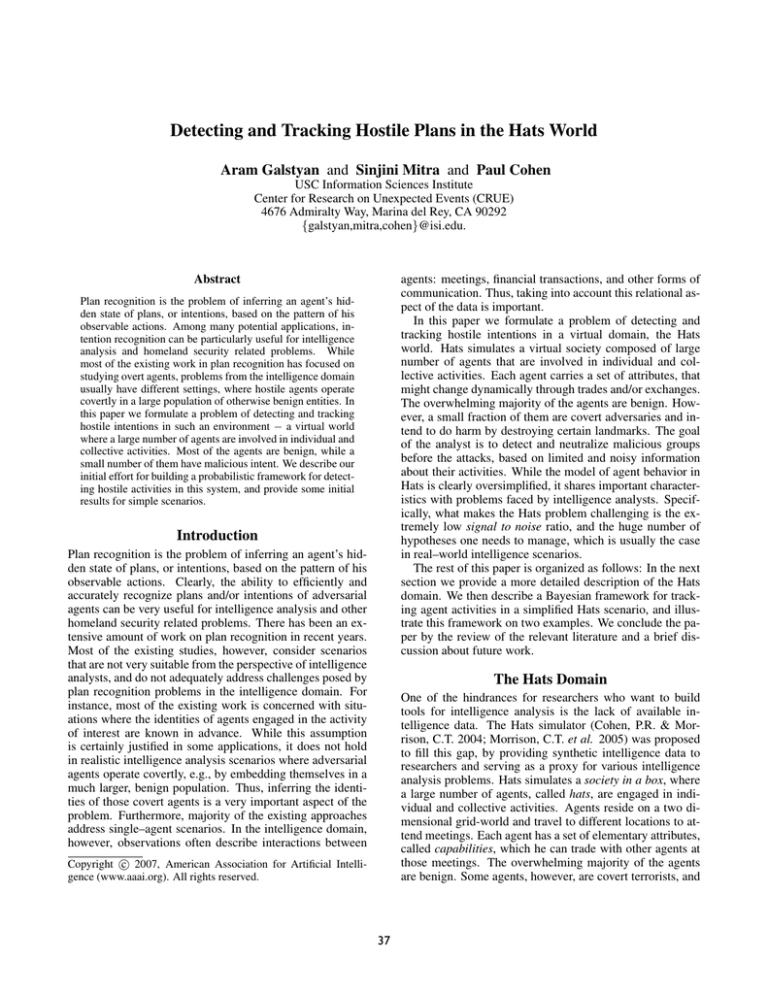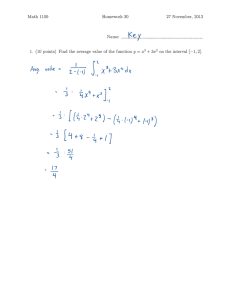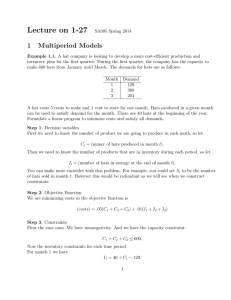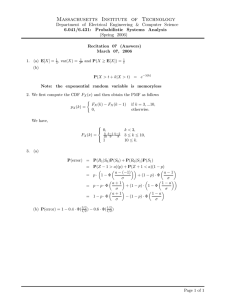
Detecting and Tracking Hostile Plans in the Hats World
Aram Galstyan and Sinjini Mitra and Paul Cohen
USC Information Sciences Institute
Center for Research on Unexpected Events (CRUE)
4676 Admiralty Way, Marina del Rey, CA 90292
{galstyan,mitra,cohen}@isi.edu.
agents: meetings, financial transactions, and other forms of
communication. Thus, taking into account this relational aspect of the data is important.
In this paper we formulate a problem of detecting and
tracking hostile intentions in a virtual domain, the Hats
world. Hats simulates a virtual society composed of large
number of agents that are involved in individual and collective activities. Each agent carries a set of attributes, that
might change dynamically through trades and/or exchanges.
The overwhelming majority of the agents are benign. However, a small fraction of them are covert adversaries and intend to do harm by destroying certain landmarks. The goal
of the analyst is to detect and neutralize malicious groups
before the attacks, based on limited and noisy information
about their activities. While the model of agent behavior in
Hats is clearly oversimplified, it shares important characteristics with problems faced by intelligence analysts. Specifically, what makes the Hats problem challenging is the extremely low signal to noise ratio, and the huge number of
hypotheses one needs to manage, which is usually the case
in real–world intelligence scenarios.
The rest of this paper is organized as follows: In the next
section we provide a more detailed description of the Hats
domain. We then describe a Bayesian framework for tracking agent activities in a simplified Hats scenario, and illustrate this framework on two examples. We conclude the paper by the review of the relevant literature and a brief discussion about future work.
Abstract
Plan recognition is the problem of inferring an agent’s hidden state of plans, or intentions, based on the pattern of his
observable actions. Among many potential applications, intention recognition can be particularly useful for intelligence
analysis and homeland security related problems. While
most of the existing work in plan recognition has focused on
studying overt agents, problems from the intelligence domain
usually have different settings, where hostile agents operate
covertly in a large population of otherwise benign entities. In
this paper we formulate a problem of detecting and tracking
hostile intentions in such an environment − a virtual world
where a large number of agents are involved in individual and
collective activities. Most of the agents are benign, while a
small number of them have malicious intent. We describe our
initial effort for building a probabilistic framework for detecting hostile activities in this system, and provide some initial
results for simple scenarios.
Introduction
Plan recognition is the problem of inferring an agent’s hidden state of plans, or intentions, based on the pattern of his
observable actions. Clearly, the ability to efficiently and
accurately recognize plans and/or intentions of adversarial
agents can be very useful for intelligence analysis and other
homeland security related problems. There has been an extensive amount of work on plan recognition in recent years.
Most of the existing studies, however, consider scenarios
that are not very suitable from the perspective of intelligence
analysts, and do not adequately address challenges posed by
plan recognition problems in the intelligence domain. For
instance, most of the existing work is concerned with situations where the identities of agents engaged in the activity
of interest are known in advance. While this assumption
is certainly justified in some applications, it does not hold
in realistic intelligence analysis scenarios where adversarial
agents operate covertly, e.g., by embedding themselves in a
much larger, benign population. Thus, inferring the identities of those covert agents is a very important aspect of the
problem. Furthermore, majority of the existing approaches
address single–agent scenarios. In the intelligence domain,
however, observations often describe interactions between
The Hats Domain
One of the hindrances for researchers who want to build
tools for intelligence analysis is the lack of available intelligence data. The Hats simulator (Cohen, P.R. & Morrison, C.T. 2004; Morrison, C.T. et al. 2005) was proposed
to fill this gap, by providing synthetic intelligence data to
researchers and serving as a proxy for various intelligence
analysis problems. Hats simulates a society in a box, where
a large number of agents, called hats, are engaged in individual and collective activities. Agents reside on a two dimensional grid-world and travel to different locations to attend meetings. Each agent has a set of elementary attributes,
called capabilities, which he can trade with other agents at
those meetings. The overwhelming majority of the agents
are benign. Some agents, however, are covert terrorists, and
c 2007, American Association for Artificial IntelliCopyright gence (www.aaai.org). All rights reserved.
37
get and an organization that will carry out the attack. Then,
a task–force composed of the members of that organization
is chosen. This task–force determines the group of agents
that will participate in the final meeting at the location of
the beacon. Next, the planner will generate a schedule for
meetings and trades, so that members of the task–force acquire capabilities matching the vulnerability of the beacon.
Finally, after all the capabilities are acquired, the task–force
members will move to the location of the beacon for the final meeting. We note that only highlighted nodes produce
directly observable actions.
Attack
Choose Target
Generate
Task Force
{H1, H2,...Hm}
Choose
Organization
Accumulate
Capabilities
for TF
Move TF to
the target
Observations
Accumulate
Capabilities
for H1
Generate
Meeting Tree
for H2
Accumulate
Capabilities
for H2
Meet(H2,...)
...
...
Accumulate
Capabilities
for Hm
Bayesian Framework for Tracking
Meet(H2,...)
We now consider a simplified Hats scenario with only two
organizations, one benign and one terrorist. Furthermore,
we assume that each agent can hold only one capability at
any given time. Let us characterize the state of the i-th agent
at time n by a tuple xin = (ξni , αni , θni ). Here ξni ∈ {0, 1} is a
terrorist indicator variable for agent i, so that ξni = 1 means
that agent i is a member of the terrorist organization; αni ∈
{0, 1, 2, . . . , M } indicates the intention of the i-th agent to
acquire a certain capability out of M possible ones (αni = 0
means the agent does not intend to get any capability at all);
and θni denotes the actual capability carried by the agent i at
time n, e.g., θni = k, k ∈ {1, 2, . . . , M }. The joint state of
the system is defined by xn = {x1n , x2n , ..., xN
n }. Initially, all
our knowledge is represented by the prior distribution over
the states, P0 (x0 ). Usually, this prior distribution will have
a factored representation owing to independence among the
individual agents at the beginning,
Observations
Figure 1: Hierarchical representation of a plan
intend to inflict harm by destroying certain landmarks called
beacons. Beacons are special locations on the grid and are
characterized by their vulnerabilities. A successful attack
on a beacon happens when a group of adversarial agents
moves to the location of a beacon and has all the capabilities that match the beacon vulnerabilities. Beacon attacks
are planned by a generative planner that chooses the target,
sets up a task-force, and builds a meeting schedule for the
task-force members, so that they will acquire the capabilities required for the attack.
Along with the covert adversaries, there also are hats that
are known to be adversaries. Each hat belongs to one or
more organizations that can be of two types, benign or adversary. Each adversarial hat belongs to at least one adversary
organization, while each benign agent belongs to at least one
benign organization and does not belong to any adversary
organization. When a meeting is planned, the list of participants is drawn from the set of hats belonging to the same
organization. Consequently, a meeting planned by an adversary organization will consist of only adversary (either
known or covert) hats, whereas a meeting planned by a benign organization might contain all types of hats.
Instead of choosing a task–force that already possesses
the required capabilities, the planner designs an elaborate
sequence of meetings for passing capabilities among the
agents. This is intended for masking the true intention of the
task–force. In the Hats simulator, the actual plans are constructed as inverted trees, where each node describes a meeting between agents, and the root node corresponds to the final meeting at the beacon. More information about meeting
planner in Hats can be found in (Cohen, P.R. & Morrison,
C.T. 2004; Morrison, C.T. et al. 2005). For the purposes
of this paper, however, we will consider a little simplified
model for plans. In particular, we assume that the observable activities are a result of a certain hidden generative process, that can be represented hierarchically as depicted in
Figure 1. Namely, the attack is planned by choosing a tar-
N
P0 (x0 ) = P10 (x10 )P20 (x20 ) . . . PN
0 (x0 ),
i
i
P0 (x0 ) represents our prior belief about
(1)
the i–th
where
agent.
Starting from the initial state, agents will participate in
meetings and might change their internal state by acquiring
capabilities at those meetings. We characterize this hidden
state dynamics by a Hidden Markov Model (HMM) with
observation–dependent state transitions as depicted in Figure 2. Here Xn and Yn are the hidden state and observation (e.g., observed meetings) at time n, respectively. The
influence diagram shows that the hidden state at time n + 1
depends on the hidden state at time n, as well as the observation at time n. The reason for the latter dependence is that
Xn
Yn
Xn+1
Yn+1
Figure 2: Schematic diagram of an HMM with states depending on observations.
38
Bayesian Guilt by Association (GBA) Model
whether an agent will change its state (e.g., acquire a certain capability) depends on the meeting it has participated in
(e.g., observation). At the same time, the observation at time
n is determined only by the corresponding hidden state Xn .
To specify the HMM we need to define the transition matrix and the emission model. The transition matrix is given
by
In the first example, we neglect any capability trades, and
focus on estimating group–membership of agents, based on
the observation of meetings between them. Specifically, assume there are N agents indexed i = 1, .., N , each of which
can belong to one of two organizations: one adversary, and
the other benign. Thus, the state of the system is fully characterized by a binary vector x = {ξn1 , ξn2 , ...ξnN }. Also, let
us assume that agents never change their adversary/benign
status, so the time index can be dropped.
Let us now specify the emission model. For the sake of
simplicity, we will assume that at any given time, a meeting contains only two agents. Thus, each observation can be
represented as a pair of agent ID–s: yn = {i, j}. Further,
we assume that the probability of a meeting between same
agents (that is, both adversary or both benign) is p > 0.5,
and the probability of a meeting between agents from different groups (one adversary and one benign) is 1 − p. In other
words, probability of a meeting between agents i and j is p
if ξ i = ξ j , and 1 − p if ξ i = ξ j . This can be written as
follows:
M (x, x ; y) = P(Xn = x|Xn−1 = x , Yn−1 = y), (2)
which is the probability that the system will be in state
Xn = x at time n, given that it was in state Xn−1 = x
and produced an observation Yn−1 = y at time n − 1.
The emission model specifies the probability of seeing a
particular observation in a particular state:
Ψ(y, x) = P(Yn = y|Xn = x).
(3)
The Bayesian filtering problem is concerned with assessing the state of the system at time n given the history of
observations up to time n, y0n = {y0 , y1 , ..., yn }. This
is done through estimating the so called filtering distribution Pn (x) = P(Xn = x|y0n ). In practice, it is easier to
work with the un–normalized filtering distribution defined
as Φn (x, y0n ) = P(Xn = x, Y0n = y0n ). The normalized
distribution is obtained by dividing Φn (x, y0n ) by the data
likelihood:
Pn (x) =
Φn (x, y0n )
Φn (x, y0n )
=
n .
P(y0n )
x Φn (x, y0 )
Ψ(y = {i, j}, x = {ξ1 , .., ξ N }) = pδ(ξ i , ξ j ) + (1 − p)
(8)
×(1 − δ(ξ i , ξ j )),
where we have used the Kronecker’s δ–function: δ(i, j) = 1
if i = j, and δ(i, j) = 0, i = j.
We now specify the transition matrix. Since agents do not
change their organization (e.g., no recruitment), there are
simply no transitions. Thus, the state transition is described
by the identity matrix:
(4)
We now derive a recursive equation for Φn (x, y0n ) as follows. Let us write it as
Φn (x, y0n )
= P(Yn = yn |Xn = x, Y0n−1 = y0n−1 )
×
=
P(Xn = x, Y0n−1 = y0n−1 )
Ψ(yn , x) × P(Xn =
x, Y0n−1
=
M (x, x ; y) = δ(x, x ).
y0n−1 ),
Plugging Equation 9 into 7 yields the following simple
recursion rule:
(5)
where in the last equation we have used the fact that, conditioned on state Xn , the observation at time n, Yn , does not
depend on previous observations.
Let us now rewrite the second term as follows:
Φn (x, y0n ) = Ψ(yn , x) × Φn−1 (x, y0n−1 )
P(Xn = x, y0n−1 ) =
P(Xn = x, Xn−1 = x , y0n−1 ) =
x
P(Xn = x|Xn−1 = x , y0n−1 )P(Xn−1 = x , y0n−1 )
x
=
M (x, x ; yn−1 )Φn−1 (x , y0n−1 ).
(9)
(6)
x
Substituting Equation 6 into Equation 5 we arrive at the
following recursive update formula:
M (x, x ; yn−1 )Φn−1 (x , y0n−1 )
Φn (x, y0n ) = Ψ(x, yn )
x
(7)
Once an emission model and state transition model are
specified, Equation 7 can be used for state estimation. Below
we apply this framework to a couple of simple examples.
39
(10)
Note that given Φn (x, y0n ), or more precisely, its normalized form Pn (x = {ξ 1 , ξ 2 , ..., ξ N }), one can calculate the
marginal probability that a given agent is a terrorist, by summing over all the other agents. In Fig. 3 we show these individual probabilities for a system of 20 agents, 10 of which
have known identities and the remaining 10 are unknown
(half of them are benign and the other half are terrorist).
The value of the parameter is p = 0.8. In this particular
experiment, the algorithm correctly identifies five covert adversaries, which is reflected in high posteriors for the corresponding agents. We also note that the exact tracking performed here becomes infeasible for sufficiently large systems as the state space grows exponentially with the number
of agents. Thus, one will have to resort to approximate methods such as Markov Chain Monte Carlo (MCMC) and particle filters. In particular, we will be investigating the application of Sequential Importance Sampling (SIS; (Doucet, A.,
de Freitas, N., & Gordon, N. Eds. 2001)), which is known
to be helpful in estimating the filtering distribution in case
of high-dimensional data.
2. If the initiator agent is not in search of a capability (e.g.,
either αi = 0, or θi = αi ), then the second agent will
be chosen without any regard to his capability, e.g., each
capability will be chosen with equal probability p0 =
1/(M +1). And if the initiator agent i is in search of a capability, e.g., θni = αni , then with probability p1 > p0 the
donor agent will be chosen among the agents that carry
that capability.
Using the simple rules above, we can define the emission
model Ψ(yn = {i → j}, xn ), e.g., calculate the probability
of seeing an observation {i → j} assuming that the system is in state xn = {x1n , x2n , ..., xN
n }. Clearly, since the
meeting involves two agents i and j, the probability of seeing such a meeting is affected by the states of i and j, e,g,
Ψ(yn = {i → j}, xn ) = Ψ(yn = {i → j}, xin , xjn ). Furthermore, as we elaborated above, the probability of such a
meeting depends on two independent factors: first, on the
group membership, and the second, on the intentions and
capabilities. Thus, we represent Ψ(yn , xin , xjn ) a product of
two functions:
Ψ(yn = {i → j}, xin , xjn ) =
1
0.9
0.8
i
Pr( =1)
0.7
0.6
0.5
0.4
1
2
3
4
5
6
7
8
9
10
0.3
0.2
0.1
0
0
10
20
30
40
50
60
70
80
90
100
Tick
Figure 3: Marginal probabilities (y-axis) of being a terrorist
vs time (shown as tics on the x-axis) for 8 agents represented
by different colored lines. There is a total of 20 agents in
this experiment, of which the identities of 10 are not known
(half of them are benign and the other half are terrorist). The
probability of a meeting between similar agents is p = 0.8.
Ψ1 (yn = {i → j}, ξni , ξnj ) ×
Ψ2 (yn = {i → j}, αni , θni , θnj ).
(11)
The first term of the product Ψ1 (yn = {i → j}, ξni , ξnj )
is the same as the emission model from the GBA example:
Ψ1 (yn = {i → j}, ξni , ξnj ) = pδ(ξ i , ξ j ) +
Tracking Capabilities
Here we consider a little more general model of agents that
are engaged in capability trades. Again, we consider a set
of N agents, each belonging to one of two organizations,
one terrorist and the other benign. The state of the system is
defined by xn = {x1n , x2n , ..., xN
n }. Initially, all our knowledge is represented by the prior distribution over the states,
P0 (x0 ).
To trade capabilities, agents engage in meetings with
other agents. For the sake of mathematical simplicity, we
assume that the meetings for the capability trades are directed, in the sense that there is an initiator agent, and there
is a donor agent. Thus, each observation is an ordered pair
yn = {i → j}. The initiator agent i is the one who is trying
to acquire the capability, and the donor agent j is the agent
from whom this capability might be acquired. We note that
observing a meeting {i → j} does not necessarily mean that
i acquired its intended capability from j: first of all, j might
lack the required capability. And second, even if j possesses
the capability, we will assume that there is a certain probability that the trade will fail. Thus, an agent who is after
a certain capability might have to meet with more than one
donor before he finally acquires the capability.
Next, we need to specify the rules according to which the
meetings are generated. We assume that they are generated
according to a certain probabilistic process. Namely, as in
the GBA model from the previous section, we assume that
the meetings are more likely to happen between agents from
the same group. Furthermore, we assume that agents that
intend to acquire a specific capability will tend to meet with
agents that actually carry that capability. Specifically, at first
the planner randomly chooses an initiator agent, i. Then the
donor agent is chosen as follows:
(1 − p)(1 − δ(ξ i , ξ j )).
(12)
And the second term is the probability that the initiator agent
i with intentions αi and capability θi will meet a donor agent
j with capability θj . According to the probabilistic rules
specified above, this function can be written as follows:
Ψ2 (yn = {i → j}, αi , θi , θj ) =
p0 × [δ(αi , 0) + δ(αi , θi )]
+[1 − δ(αi , 0)][1 − δ(αi , θi )]
×[p2 δ(θj , αi ) + p0 (1 − p2 )].
(13)
For instance, the first term describes the case where the agent
i has no intention of acquiring a capability (i.e, δ(αi , 0) =
1), or it has already acquired the capability (i.e., δ(αi , θi ) =
1). Then the emission function does not depend on the
donor’s capability θj , and evaluates to Ψ2 (yn = {i →
j}, αi , θi , θj ) = p0 .
To complete the model definition, we must also specify
the transition matrix. Again, for simplicity we assume that
the group membership and intention to acquire a capability
do not change, e.g., ξni ≡ ξ i and αni ≡ αj are set in the beginning and never change. Thus, the only dynamic variables
are θni , i.e., the actual capabilities carried by the agents. Furthermore, we note that only the initiator agent can change
its state (i.e., by acquiring a capability), and the state of the
donor agent remains unchanged. Thus, the transition probabilities are as follows:
M (xn , xn−1 , y) ≡ P(xn |xn−1 , yn−1 = {i → j})
i
, ξni ) ×
= δ(xjn , xjn−1 ) × δ(ξn−1
1. With probability p > 1/2, it will belong to the same group
as agent i. i.e., ξ j = ξ i .
j
i
i
, αni ) × T (θni ; αi , θn−1
, θn−1
),
δ(αn−1
40
(14)
j
i
where T (θni ; αi , θn−1
, θn−1
) is the probability that after the
meeting {i → j}, the agent i will have the capability θni ,
provided that at time n − 1, i had the intention αi and capai
i
, and j had the capability θn−1
. Let us determine
bility θn−1
this probability according to the following rules:
quired. Again, we note that exact tracking becomes infeasible for sufficiently large systems because of the exponential
explosion in the size of the state space. We are currently examining different approximation techniques, such as using
factored representations of the belief state, that will allow us
to consider a large number of agents.
1. If the agent i has no intention of acquiring a specific capability (αi , = 0) or has already acquired the capability
i
= αi ), then no trade happens, e.g.,
he intended (θn−1
i
.
θni = θn−1
Related Work
In this section we review existing probabilistic models for
plan recognition. Probabilistic Hostile Agent Task Tracker
(PHATT) (Geib, C.W. & Harp, S.A. 2004; Geib, C.W. &
Goldman, R.P. 2005) is a hybrid symbolic–probabilistic plan
recognizer, where the symbolic approach is used to filter
out inconsistent hypotheses. The remaining consistent hypotheses are then evaluated probabilistically. PHATT assumes that initially the executing agent has a set of goals
and chooses a set of plans to achieve these goals. The set of
plans chosen determines a set of pending primitive actions.
The observations of the agent’s actions are taken as an execution trace and the conditional probability of each of the
root goals are determined given the observed series of actions. Another hybrid symbolic–probabilistic model developed in (Avrahami-Zilberbrand, D. & Kaminka, G.A. 2006)
combines a symbolic plan recognizer with a probabilistic inference framework based on Hierarchical Hidden Markov
Model (HHMM). This approach computes the likelihood of
the consistent hypotheses obtained from the symbolic recognizer, ranks them, and then determines the hypothesis with
the maximum posterior probability (called the probable current state hypothesis). It can efficiently deal with a richer
class of plan recognition challenges, such as, recognition
based on duration of behaviors, and recognition of interleaved plans (where an agent interrupts a plan for another,
only to return to the first one later).
Much recent work has considered using various generalizations of Hidden Markov Models for plan recognition. The
Cascading Hidden Markov Model (CHMM) (Blaylock, N.
& Allen, J. 2006) uses an extension of the traditional HMM
to simultaneously recognize an agent’s current goal schemas
at various levels of a hierarchical plan. Bui et al proposed a
probabilistic plan recognition framework based on Abstract
Hidden Markov Models (AHMM) (Bui, Venkatesh, & West
2002). This approach allows to identify an agent’s behavior in dynamic, noisy, uncertain domains and across multiple levels of abstraction. They also describe an approximate inference technique based on Rao-Blackwellized Particle Filter (RBPF) that allows an efficient, hybrid inference
method for this model, that scales well with the number of
levels in the plan hierarchy. The AHMM has a memoryless
property, that is, the policies in the AHMM cannot represent a sequence of uninterrupted sub-plans and thus the decision to choose the next sub-plan is only dependent on the
current state, and not on the sub-plans that were chosen in
the past. This issue has been addressed by extending the
AHMM model to include a memory flag (Bui, H.H. 2003).
Probabilistic State-Dependent Grammars (PSDG), suggested in (Pynadath, D.V. & Wellman, M.P. 2000) are used
to represent an agent’s plan generation process and are
closely related to the AHMM approach. The PSDG can
2. If the agent i has not yet acquired its intended capability,
i
= αi and αi = 0, then, if the second agent
i.e., θn−1
j
carries that capability, θn−1
= αi , then with probability
j
= αi , (i.e.,
γ he will acquire this capability. And if θn−1
the donor agent j does not possess the required capability), then nothing changes. To simplify the notation, let us
define δ̃(i, j) = 1 − δ(i, j).
Putting all these together, we arrive at the following:
j
i
, θn−1
)
T (θni ; αi , θn−1
i
i
= [δ(αi , 0) + δ(αi , θn−1
)]δ(θni , θn−1
)
j
i
i
+δ̃(αi , 0)δ̃(αi , θn−1
)
)δ̃(αi , θn−1
)δ(θni , θn−1
j
i
)δ(αi , θn−1
)δ(θni , αi )
+γ δ̃(αi , 0)δ̃(αi , θn−1
j
i
i
)δ(αi , θn−1
)δ(θni , θn−1
). (15)
+(1 − γ)δ̃(αi , 0)δ̃(αi , θn−1
The first line on the RHS of Equation 15 corresponds to the
case when the agent i either does not intend to acquire a capability, or has already acquired it. In this case i’s capability
i
). The secdoes not change which is reflected in δ(θni , θn−1
ond line describes the case when i intends to acquire a capability and has not done so yet, but agent j does not carry the
required capability. Again, the last term in the product ensures that the capability does not change. Further, the third
and fourth lines describe the case when j actually carries
the required capability – the third line describes a successful trade with probability γ, and the fourth line describes a
failed trade with complementary probability 1 − γ.
Equations 11–15 complete the definition of the simple capability tracking model. Using the distribution Pn (Xn ),
one can get probabilistic answers to various questions of interest. For instance, to find out whether the organization is
trying to acquire a set of capabilities {C1, C2}, let us define an indicator function I(i, j), which is equal to 1 if the
agents i and j are terrorists and have the intention to acquire capabilities C1 and C2 between them, and 0 otherwise. Using Kronecker’s notation again, this function is represented as I(i, j) = δ(ξ i , 1)δ(ξ j , 1)[δ(αi , C1)δ( αj , C2) +
δ(αi , C2)δ(αj , C21)]. Using this indicator function and
the filtering distribution Pn (Xn ), we can estimate the
likelihood of different hypotheses. For instance, our belief that the organization is indeed engaged in a mission
to acquire the capacities
as follows:
can be calculated
Pn (mission=true) = 1− X Pn (X) i,j [1−I(i, j)]. Similarly, one can define a different indicator function over the
actual carried capabilities to estimate the probability that the
set (or a subset) of the capabilities have already been ac-
41
be described as the Probabilistic Context Free Grammar
(PCFG) augmented with a state space, and a state transition probability table for each terminal symbol of the PCFG.
They use an exact inference method to deal with the case
where the states are fully observable. When the states are
partially observable, a brute-force approach is suggested
which increases the complexity of the method.
YOYO (Kaminka, G.A., Pynadath, D.V., & Tambe, M.
2002)) is an efficient probabilistic plan recognition algorithm to monitor the state of a team of agents from the members’ routine conversations (hence overhearing) exchanged
as part of their coordinated task execution. YOYO exploits
knowledge about the team’s social behavior to predict future
observations during execution (thereby reducing monitoring
uncertainty). The approach is scalable, and can handle missing observations. One of the drawbacks is that messages are
assumed to be truthful, hence there is no way of detecting
deception here which may be an issue in practice. Also, the
method is based on the implicit assumption that the team,
its members and the social structure among them are known
beforehand.
As mentioned earlier also, the primary drawback of many
of these methods is that they assume a known identity of the
agent that one wants to track, and that there is only a moderately large number of potential plans. This is clearly not
practical in realistic intelligence analysis applications where
one usually deals with a huge number of agents with a large
library of plans at their disposal, from which one wants to
find the few that may be of interest in some sense. Such a
scenario thus involves a large network of hypotheses that requires efficient hypothesis management tools with the goal
of determining the relevant ones. An example of such a system is provided by the Hats world. The latter is a simple
prototype for terrorist networks that are operational in the
real world, and involve a huge amount of transactional data
in the form of phone conversations, meetings and so on between many agents, a few of whom are expected to carry out
a harmful mission. Moreover, very few plan recognition systems deal with team behavior based on coordination among
the members. Therefore, none of the existing techniques are
capable of providing a rigorous tracking and detection algorithm for handling plans of such complex nature as those
involved in a domain like Hats, and our method is a first effort in that direction that has the potential to overcome the
shortcomings of most of the current approaches .
not pay any attention. We note, however, that in more interesting adversarial scenarios, agents might utilize deception, e.g., by demonstrating a certain behavior temporarily
to cover their true intent. This type of deliberately deceptive
behavior goes beyond the scope of this paper, and has not
ben covered here.
We have also described our initial steps for building a
probabilistic framework for detecting and tracking hostile
activities in Hats. Specifically, we described a recursive
equation for updating beliefs (i.e., filtering distribution) once
new observations are made available. Clearly, tracking
the joint filtering distribution is computationally infeasible
when the number of agents is sufficiently large. One of the
ways for reducing computational complexity of the tracking problem is to group variables (e.g., agents) so that variables across the groups have little or no correlation. One can
then approximate the joint distribution function by a product
of factored distributions over those groups (Boyen & Koller
1998; Murphy & Weiss 2001). For instance, if one knew the
members of the organizations in advance, we could leave
out other agents, thus significantly reducing the problem dimensionality. Moreover, grouping members of organization
together has another advantage. Namely, if all the members of the organization are known in advance, then the observations about individual members can be aggregated to
make inferences about the organization. In other words, if
the tracking has revealed that a certain member of the organization intends to acquire a certain capability, then this
indicates that the organization itself intends to get that capability. This suggests that one can try to find organizations based on transaction data, and for detecting groups of
strongly connected (or highly correlated) nodes in transactional networks. Algorithms for detecting groups of strongly
connected (or highly correlated) nodes in transactional networks have been proposed in (Newman & Girvan 2004;
Danon et al. 2005; Galstyan & Cohen 2005; 2006).
Finally, we would like to note that the emission and the
transition probabilities in our model consist of parameters
that are, generally speaking, unknown in advance. Instead,
these parameters have to be estimated using an Expectation–
Maximization (EM) approach, where one starts with some
initial values for each of the unknown parameters (based on
prior knowledge) and continue the re-estimation process until it converges to the particular values that maximizes the
likelihood function, thud yielding the Maximum Likelihood
Estimate (MLE) of the model parameters. We intend to address this learning problem in our future work.
Discussion and Future Work
In this paper we have formulated a problem of detecting and
tracking hostile activities in a virtual Hats domain. Despite
the over–simplified models of agent behavior, the Hats domain still attains the most important characteristics of real
world intelligence analysis problems: low signal to noise ratio, and huge number of possible hypotheses one must manage. Thus, we believe that developing successful detection
and tracking techniques for Hats will certainly be valuable
for more realistic problems as well. The scenario considered here is a keyhole plan recognition, e.g., it is assumed
that agents who are being planned are not aware of it, or do
Acknowledgment
This research is supported in part by an ARO MURI grant
50363-MA-MUR.
References
Avrahami-Zilberbrand, D., and Kaminka, G.A. 2006. Hybrid symbolic-probabilistic plan recognizer: Initial steps.
In Proceedings of AAAI workshop on modeling others from
observations (MOO-06).
42
Blaylock, N., and Allen, J. 2006. Fast hierarchical goal
schema recognition. In Proceedings of AAAI-06.
Boyen, X., and Koller, D. 1998. Approximate learning of
dynamic models. In Proceedings of NIPS-11, 1998.
Bui, H.H. 2003. A general model for online probabilistic
plan recognition. In Proceedings of IJCAI’03.
Bui, H.; Venkatesh, S.; and West, G. 2002. Policy recognition in the abstract hidden markov models. Journal of
Artificial Intelligence Research 17:451–499.
Cohen, P.R., and Morrison, C.T. 2004. The hats simulator.
In Proceedings of the 2004 Winter Simulation Conference,
849–856.
Danon, L.; Dı́az-Guilera, A.; Duch, J.; and Arenas, A.
2005. Comparing community structure identification.
Journal of Statistical Mechanics: Theory and Experiment
2005(09):P09008.
Doucet, A.; de Freitas, N.; and Gordon, N. Eds. 2001.
Sequential Monte Carol Methods in Practice. Springer.
Galstyan, A., and Cohen, P. R. 2005. Inferring useful
heuristics from the dynamics of iterative relational classifiers. In Proceedings of IJCAI-05, 19th International Joint
Conference on Artificial Intelligence.
Galstyan, A., and Cohen, P. R. 2006. Relational classification through three–state epidemic dynamics. In Submitted to The 9th International Conference on Information
Fusion, Florence, Italy.
Geib, C.W., and Goldman, R.P. 2005. Partial observability
and probabilistic plan/goal recognition. In Proceedings of
the International workshop on modeling other agents from
observations (MOO-05).
Geib, C.W., and Harp, S.A. 2004. Empirical analysis
of a probabilistic task tracking algorithm. In Proceedings
of Workshop on Agent Tracking, Autonomous Agents and
MultiAgent Systems (AAMAS).
Kaminka, G.A.; Pynadath, D.V.; and Tambe, M. 2002.
Monitoring teams by overhearing: A Multi-agent plan
recognition approach. Journal of Artificial Intelligence Research 17:83–135.
Morrison, C.T.; Cohen, P.R.; King, G.W.; Moody, J. J.;
and Hannon, A. 2005. Simulating terrorist threat with the
hats simulator. In Proceedings of the First International
Conference on Intelligence Analysis.
Murphy, K., and Weiss, Y. 2001. The factored frontier
algorithm for approximate inference in DBNs. In UAI–01.
Newman, M. E. J., and Girvan, M. 2004. Finding and
evaluating community structure in networks. Phys. Rev. E
69:026113.
Pynadath, D.V., and Wellman, M.P. 2000. Probabilistic
state-dependent grammars for plan recognition. In Proceedings of Sixteenth Annual Conference on Uncertainty
in Artificial Intelligence (UAI’00).
43






